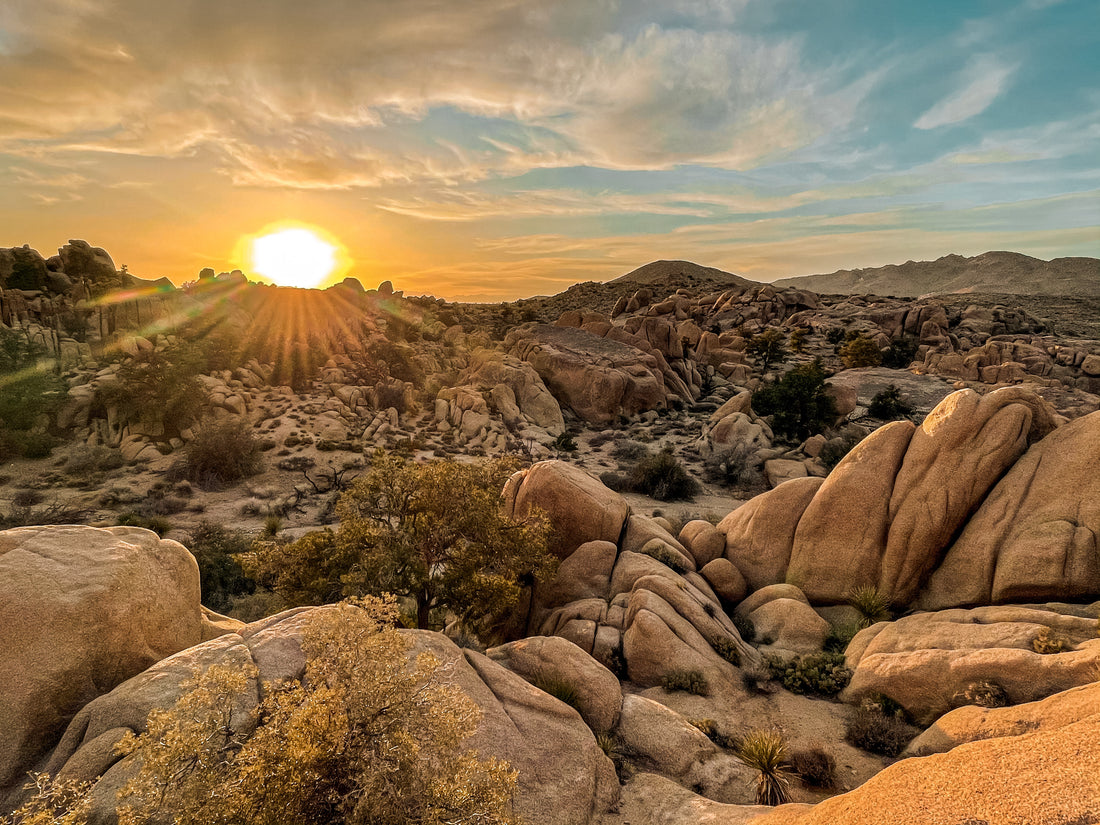
What to do in Joshua Tree National Park
Share
Getting There
Joshua Tree National Park is located in Southern southern California, a few hours drive from Los Angles, Phoenix, Las Vegas, and San Diego. Palm Springs is the closest airport. The park is open 24 hours a day, 365 days a year. You’ll need a Joshua Tree visitors pass ($30 per car) ($30 per car for 7 days) or a National Parks pass to enter the park. You can purchase either from the visitors center or toll stations when entering the park or online.
The park has 6 access points, 3 are connected by the main park road while 3 are single-access points for hiking trails or campgrounds on the edge of the park.
We drove in through the Cottonwoods entrance on the south side of the park from I10 and out through the west entrance in Joshua Tree. The cottonwoods entrance is convenient any time of day because you do not have to go through an entrance station. After a few days in the park, we visited Indian Cove to camp and FortyNine Palms entrance to hike.
Pro-tip, arrive early (before 8) if you’re planning on using the Joshua Tree entrance to the northwest, it was backed up at the fee station because they only have one lane of traffic going through the gate.
Facilities
Water & Restrooms - Like many desert parks water is scarce. There are no drinking water points in the middle of the park. The majority of toilets are pit toilets and there are no shower facilities. The desert sun is hot though so pick up a solar shower (link) before you go and you’ll be squeaky clean!
Gas - The park is quite big (800,000 acres!) and there are no gas stations within the park borders. The largest gateway community to the northwest has full facilities including gas. From the south we recommend you go in with a full tank so you don’t miss out on any adventures.
Food - There are no restaurants or concessions in the park so stock up in the surrounding cities before entering. Make sure you take out what garbage you can as well, they do recycle glass and aluminum within the park.
Where to Sleep
There are multiple campgrounds in the park, we got lucky and found last-minute spots at Jumbo Rocks and Indian Cove campground using the recreation.gov app. All the campgrounds we saw looked really cool, in the upper elevations of the park, many of the campsites were nestled up against rock formations close to beautiful scenery. The lower cottonwood campground is a little less scenic but does have a dump station with running water.

Backcountry camping is unique in Joshua Tree. The process is extremely easy but takes some route planning and an adventurous spirit. The park has designated backcountry starting point locations. You just need to fill out a (free) permit at your chosen starting point. We did this the one night we couldn’t get a campground from the Pine City lot and it was an easy hike to find a beautiful spot. It was however very cold (36 degrees🥶) and windy so be prepared.
If you’d like to stay outside the park there are multiple free BLM campgrounds nearby or paid campgrounds in nearby Joshua Tree and Palm Springs. There is also a great selection of unique Airbnbs nearby if you’re looking for some more luxurious accommodations.
What we did

We hiked some small trails - Cholla Cactus Garden, Skull Rock, Discovery Trail, FortyNine Palms Oasis - we took our gravel bikes on the Geology Tour loop and backcountry camped for one night off the Lucky Boy loop trail. We spent 3 days in the park and felt we got a good feel for it but could easily have stayed another 3 days and not even come close to running out of things to do.
What we’d do next time
More backpacking! This park is huge and has so many areas to explore. We’d love to return when it’s a bit warmer overnight and try some longer backpacking routes.
What to do if you only have a day
We'd recommend entering through the west or north entrance station and drive along Park Blvd. This is where the majority of Joshua Trees and unique rock formations are. Most of the pull-outs and parking lots are trailheads for hikes of varying difficulty and length. Check the hikes page here and choose one that suits your time and energy levels!
We were both slightly skeptical about our visit, the region gets so much praise we were worried our expectations would be too high or the park would be way too crowded. We’re happy to say that our expectations were exceeded and while some locations were busy, it was easy to find quiet trails and space to be alone. We’d both love to go back and highly recommend visiting Joshua Tree to anyone, the scenery is like nowhere else and it’s truly a magical place.
